In the sprawling, high-speed world of papermaking, the final product—be it a glossy magazine page, a sturdy cardboard box, or a soft tissue—is the result of a complex and beautifully synchronized mechanical ballet. At the very heart of this dance are the paper machine rolls. These massive, precision-engineered cylinders are far more than simple components; they are the lifeblood of the entire operation. They form, press, dry, and finish the paper sheet, and their performance dictates everything from production speed and energy consumption to the final quality of the paper itself. It's why the choice of a Paper machine roll manufacturer is one of the most critical decisions a mill manager can make. It's a choice that reverberates through every inch of paper produced.
Frankly speaking, many people outside the industry see a roll as just a large piece of metal. But in reality, it's a highly sophisticated piece of technology. The difference between a standard roll and a superior one can mean the difference between a profitable, efficient operation and one plagued by constant downtime and quality issues. This article delves into what sets a world-class manufacturer apart, moving beyond the basic specifications to explore the expertise, technology, and partnership that truly matter.
The Heart of Papermaking: Why Your Choice of Manufacturer Matters
Have you ever wondered how a watery pulp slurry is transformed into a strong, uniform sheet of paper in a matter of seconds? The magic happens as the sheet travels over, under, and between dozens, sometimes hundreds, of rolls. Each roll has a specific, non-negotiable job to do. If one fails or underperforms, the entire production line can grind to a halt. This is where the pedigree of your manufacturer becomes paramount.
A premier manufacturer isn't just a supplier; they are an integral partner in your mill's success. Their understanding of the papermaking process should be as deep as their knowledge of metallurgy and engineering. In my experience, the best manufacturers work collaboratively with mills to solve problems, not just sell products. They understand that a roll designed for a linerboard machine running at 1,000 meters per minute has vastly different requirements than one for a fine paper machine producing delicate, high-gloss sheets.
The impact of a well-made roll is tangible:
- Enhanced Paper Quality: Precision-ground and perfectly balanced rolls ensure uniform moisture profiles, thickness, and smoothness, eliminating defects like barring and chatter marks.
- Increased Machine Uptime: High-quality materials and manufacturing reduce the risk of premature wear, corrosion, and catastrophic failure, leading to longer operational cycles and less unscheduled downtime.
- Improved Efficiency: Optimized roll designs and covers can improve dewatering in the press section, reducing the energy required in the dryer section—the most energy-intensive part of the machine.
- Safety: A poorly manufactured roll operating at high speeds is a significant safety hazard. A reputable manufacturer adheres to the strictest safety and quality control standards to prevent such risks.
It's worth noting that the initial investment in a high-quality roll from a reputable manufacturer often pays for itself many times over through reduced maintenance costs, lower energy consumption, and higher-quality output. It's a classic case of value over price.

Decoding the Different Types of Paper Machine Rolls
A paper machine is a city of rolls, each with its own unique address and function. A top-tier manufacturer must have the expertise to design, build, and service this entire population. While the list is extensive, the rolls generally fall into a few key sections of the machine.
Forming Section Rolls
This is where the paper sheet is born. A slurry of pulp and water is deposited onto a moving fabric, and forming rolls help to dewater the nascent sheet. Key players here include the Breast Roll, which supports the fabric at the beginning of the process, and the powerful Suction Couch Roll, a large, perforated roll that uses a vacuum to pull a significant amount of water out of the sheet before it moves to the press section. The precision of these rolls is critical for establishing a good initial sheet structure.
Press Section Rolls
After the forming section, the sheet is still incredibly fragile and saturated. The press section's job is to mechanically squeeze more water out. This is accomplished by passing the sheet through a series of nips created by large, heavy rolls. Types include Suction Press Rolls, which use vacuum and pressure, and Blind Drilled or Grooved Rolls, which provide channels for the pressed water to escape. The design of the roll covers (often rubber or polyurethane) is just as important as the roll body itself, as it dictates nip dynamics and water removal efficiency.
Dryer Section Rolls
This is the longest section of the paper machine, and for good reason. It's responsible for evaporating the remaining water. The sheet meanders over a multitude of steam-heated Dryer Cans (or cylinders). These are pressure vessels that must be manufactured to exacting standards. Interspersed are smaller Felt Rolls that guide the dryer fabrics, which press the sheet against the hot surfaces. Energy efficiency and uniform heat transfer are the primary goals here.
Calender and Reel Rolls
Once the sheet is dry, it's time for finishing. The Calender is a stack of hard, polished rolls that apply pressure and friction to the sheet to control its thickness, smoothness, and gloss. The precision of these rolls is paramount for a flawless surface. Finally, the finished paper is wound onto a large Reel Spool, creating the parent roll that will be cut into smaller rolls or sheets later on. The stability and balance of the reel spool are crucial for handling these massive, heavy parent rolls safely.
Key Qualities of a World-Class Paper Machine Roll Manufacturer
So, what truly separates the best from the rest? It's a combination of deep technical expertise, state-of-the-art facilities, and a customer-centric philosophy. When evaluating a potential partner, these are the areas to scrutinize.
Material Science and Engineering Expertise
A roll is only as good as the materials it's made from. A leading manufacturer will have metallurgists and material scientists on staff who can recommend the perfect material for any application. This includes:
- Roll Shells: Expertise in cast iron, steel, stainless steel, and even advanced composites for specific applications where weight or corrosion is a major concern.
- Roll Covers: Deep knowledge of cover materials like rubber, polyurethane, and advanced composites. They can formulate compounds to provide the ideal hardness, abrasion resistance, and chemical resistance for each position.
- Specialized Coatings: The ability to apply coatings like chrome, tungsten carbide, or ceramics for extreme wear resistance and surface properties.
To be honest, this level of material science is a game-changer. It ensures that the roll won't just fit, but will perform optimally and last longer in its specific operational environment.
Advanced Manufacturing and Precision Machining
Ideas and materials are nothing without the ability to execute. A top manufacturer's facility will be a showcase of modern manufacturing technology. Look for evidence of:
- CNC Grinding: Computer-controlled grinders capable of achieving incredibly tight tolerances for roll diameter, roundness, and profile. This is non-negotiable for producing high-quality paper.
- Dynamic Balancing: As machines get faster, the need for perfect balance becomes critical. The ability to dynamically balance rolls at their operational speed is essential for producing high-speed paper machine rolls that operate without vibration.
- Rigorous Quality Control: This includes non-destructive testing (NDT) like ultrasonic and magnetic particle testing to ensure the roll body is free from internal defects before and after manufacturing.
Customization and Design Capabilities
No two paper machines are identical. A premier manufacturer understands this and excels at providing custom paper machine rolls. They won't just build to a print; they will work with your engineers to analyze your machine's unique conditions and potentially suggest design improvements. This could involve modifying a roll's internal structure for better steam distribution in a dryer, or designing a custom crown (a slight curvature of the roll surface) to compensate for deflection under load. This collaborative design process is a hallmark of a true partner.

The Hidden Costs of Compromise: Risks of Choosing the Wrong Supplier
Choosing a manufacturer based solely on the lowest bid can be a costly mistake. The initial savings are often dwarfed by the long-term expenses that arise from an inferior product. Many experts agree that the risks are simply too high.
A poorly made roll can lead to a cascade of problems. Improperly balanced rolls cause vibrations that can damage bearings, machine frames, and other nearby equipment. A roll with poor dimensional accuracy will produce paper with inconsistent thickness and moisture profiles, leading to a higher percentage of rejected product. In the worst-case scenario, a roll with a hidden manufacturing defect could fail catastrophically at high speed, causing massive damage and posing a severe safety risk to personnel.
Furthermore, a subpar supplier is unlikely to provide the robust after-sales support needed for a critical component. When a problem arises, you need a partner who can respond quickly with technical expertise. This is where comprehensive services like on-site inspections and dedicated paper mill roll maintenance programs become invaluable, extending roll life and preventing unexpected failures.
The Future of Paper Machine Rolls: Innovations to Watch
The industry is constantly evolving, and the best Paper machine roll manufacturer is one that invests in research and development to stay ahead of the curve. The future is exciting, with several key innovations on the horizon.
Interest in "smart rolls" is growing rapidly. These are rolls embedded with sensors that can monitor temperature, vibration, and pressure in real-time. This data can be fed back to the machine's control system, allowing for automatic adjustments to optimize performance and predict maintenance needs before a failure occurs. Imagine a roll that tells you exactly when and where it needs attention!
We are also seeing continued advancements in materials. Lighter, stronger composite roll shells can reduce inertial loads and energy consumption, allowing machines to run faster. New cover compounds are being developed that offer even better wear resistance and dewatering performance, extending the time between regrinding cycles.
Ultimately, selecting a manufacturer is about building a long-term, strategic relationship. It's about finding a partner who is as invested in the quality of your paper and the efficiency of your mill as you are. By focusing on expertise, technology, and a collaborative spirit, you can ensure that the heart of your machine is strong, reliable, and ready for the challenges of modern papermaking.
For more detailed information, please visit our official website:Paper machine roll manufacturer
About the author: John Carter is a mechanical engineer with over 20 years of experience in the pulp and paper industry, specializing in machine optimization and roll technology. He has consulted for mills across the globe, helping them enhance efficiency and product quality through advanced engineering solutions. John is passionate about the intersection of material science and practical application in high-speed manufacturing environments. ---


